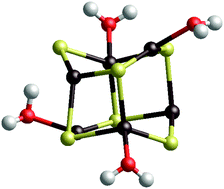The fate of optical excitations in small hydrated ZnS clusters: a theoretical study into the effect of hydration on the excitation and localisation of electrons in Zn4S4 and Zn6S6
Abstract
In this paper we explore the effect of

* Corresponding authors
a Departament de Química Física and Institut de Química Teòrica i Computacional (IQTCUB), Universitat de Barcelona, E-08028 Barcelona, Spain
b
Department of Chemistry, University College London, 20 Gordon Street, UK
E-mail:
m.zwijnenburg@ucl.ac.uk
c Institució Catalana de Recerca i Estudis Avançats (ICREA), 08010 Barcelona, Spain
In this paper we explore the effect of

 Please wait while we load your content...
Something went wrong. Try again?
Please wait while we load your content...
Something went wrong. Try again?
M. A. Zwijnenburg, F. Illas and S. T. Bromley, Phys. Chem. Chem. Phys., 2011, 13, 9311 DOI: 10.1039/C1CP20298G
To request permission to reproduce material from this article, please go to the Copyright Clearance Center request page.
If you are an author contributing to an RSC publication, you do not need to request permission provided correct acknowledgement is given.
If you are the author of this article, you do not need to request permission to reproduce figures and diagrams provided correct acknowledgement is given. If you want to reproduce the whole article in a third-party publication (excluding your thesis/dissertation for which permission is not required) please go to the Copyright Clearance Center request page.
Read more about how to correctly acknowledge RSC content.
 Fetching data from CrossRef.
Fetching data from CrossRef.
This may take some time to load.
Loading related content
